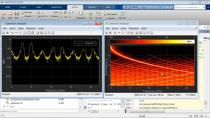dsp。CICInterpolator
Interpolate signal using cascaded integrator-comb filter
Description
Thedsp。CICInterpolatorSystem object™ interpolates an input signal using a cascaded integrator-comb (CIC) interpolation filter. The CIC interpolation filter structure consists ofNsections of cascaded comb filters, followed by a rate change by a factor ofR, followed byNsections of cascaded integrators. For details, seeAlgorithms. TheNumSectionsproperty specifiesN,number of sections in the CIC filter. TheInterpolationFactorproperty specifiesR,interpolation factor. ThegetFixedPointInfofunction returns the word lengths and fraction lengths of the fixed-point sections and the output for thedsp。CICInterpolatorSystem object. You can also generate HDL code for this System object using thegeneratehdlfunction.
Note
This object requires a Fixed-Point Designer™ license.
To interpolate a signal using a CIC filter:
Create the
dsp。CICInterpolatorobject and set its properties.Call the object with arguments, as if it were a function.
了解更多关于系统对象是如何工作的,看到的What Are System Objects?.
Creation
Syntax
Description
cicInterp= dsp.CICInterpolator
cicInterp= dsp.CICInterpolator(R,M,N)InterpolationFactorproperty set toR,DifferentialDelayproperty set toM, and theNumSectionsproperty set toN.
cicInterp= dsp.CICInterpolator(Name,Value)
Properties
Usage
Description
cicInterpOut= cicInterp(input)
Input Arguments
Output Arguments
Object Functions
To use an object function, specify the System object as the first input argument. For example, to release system resources of a System object namedobj, use this syntax:
release(obj)
For a list of filter analysis methods this object supports, typedsp。CICInterpolator.helpFilterAnalysisin the MATLAB®command prompt. For the corresponding function reference pages, seeAnalysis Methods for Filter System Objects.
Examples
More About
Algorithms
References
[1] Hogenauer, E.B. "An Economical Class of Digital Filters for Decimation and Interpolation."IEEE Transactions on Acoustics, Speech and Signal Processing. Volume 29, Number 2, 1981, 155–162.
[2] Meyer-Baese, U.Digital Signal Processing with Field Programmable Gate Arrays. New York: Springer, 2001.
[3] Harris, Fredric J.Multirate Signal Processing for Communication Systems. Indianapolis, IN: Prentice Hall PTR, 2004.




